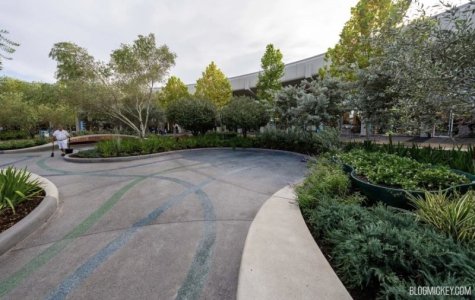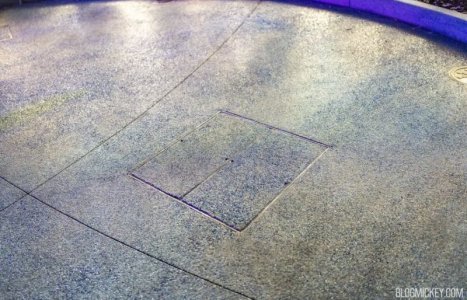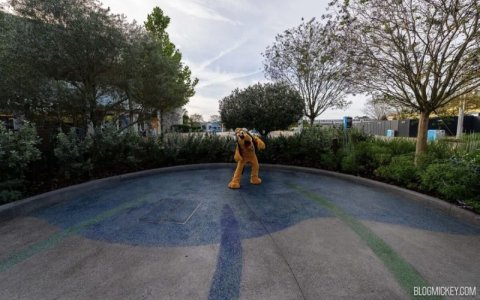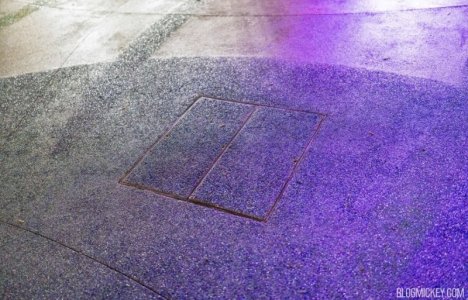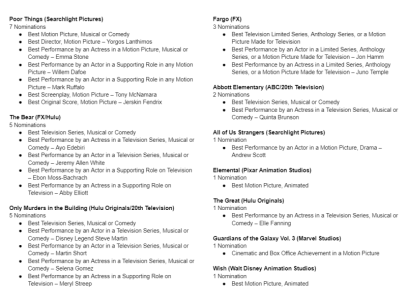https://www.sfgate.com/disneyland/article/calif-town-walt-disney-private-plane-18532852.php
How Walt Disney's private plane ended up in the Calif. desert

A closer look at Walt Disney’s private plane on display at the Palm Springs Air Museum on Dec. 1, 2023. Andrew Pridgen/SFGATE
By
Andrew PridgenDec 9, 2023
There are dozens of legendary aircraft to behold at the
Palm Springs Air Museum — a stealth fighter, a P-51 Mustang and a B-17F Flying Fortress used in the 1990 movie “
Memphis Belle” — but nothing brings out the fanatics and history buffs like an old cream-colored
Grumman Gulfstream I with an orange stripe down both sides.
Why is this relatively nondescript craft special? The call letters near the rear of the plane, N234MM, may hold the biggest clue.
“Most planes have their tail number, it starts with one letter and ends with one letter, except for this plane,” Kevin Pillow, operations manager at the
Palm Springs Air Museum, told SFGATE during a tour of the dusty airfield on Gene Autry Trail in the
shadow of the San Jacinto mountains on the eastern edge of town. “This plane, you look on top, has two letters in the end: ‘MM.’
“The MM, of course, is for Mickey Mouse.”
Or, in the words of
SFGATE Disney editor Julie Tremaine, “It all started with a mouse, but this plane ended with one.”

The call numbers on the tail of Walt Disney’s private plane gave insiders a big clue as to who was inside.
Andrew Pridgen/SFGATE
“He did get FAA approval,” Pillow continued. “And it is nicknamed ‘The Mouse.’”
The twin-prop OG private plane, held over from the early 1960s, was one of the first executive aircraft to take to the skies, starting a trend that continues today for the ultrawealthy: “A lot of people had seaplanes and things like that, but he really saw the value of high-speed commercial aviation,” Fred Bell, executive director of the Air Museum, explained to SFGATE, noting that Disney was the pioneer when it came to flying in a private aircraft. “Up until that point, most of the executive transports were World War II airplanes. So the G1 was faster, it was really built as an executive coach for him to move around. He had a workstation there. It was a comfortable aircraft. He could fly fairly high, so he didn’t have to deal with turbulence.”
“The Mouse” is currently on loan indefinitely to the Air Museum from the Walt Disney Archives, museum spokesperson Ann Greer said. “We have artifacts inside [the museum] and we show the documentary that Disney did on the history of the plane that we show every day in our little movie theater.”

Part of the display about Walt Disney’s private plane at the Palm Springs Air Museum on Dec. 1, 2023.
Andrew Pridgen/SFGATE
“Walt’s pilots would initially use the proper form of identification when they approached an airport, ‘two three four metro metro,’ a history of the plane by
Visit Palm Springs recalls. ‘Then they would try ‘two three four Mickey Mouse.’ It did not take long until F.A.A. controllers routinely called N234MM ‘Mickey Mouse.’ That’s how the plane got nicknamed just ‘The Mouse.’”
“The Mouse” is responsible for perhaps more iconic late-20th-century Disney moments than any other individual vehicle, in part because of Disney’s lifetime fascination with aeronautics.
“He believed in aviation to the point when he was in World War I he conned his way or figured out how to get on a biplane,” Bell explained. “He loved aviation.
“Later in life he realized aviation could make him more productive. When he got past the studio phase and became more bicoastal, first with the World’s Fair and then with Disney World, he stepped into one of the first Gulfstreams and realized he could work all the way there and all the way back.”

An example of what the interior looked like in Walt Disney’s private plane, on display at the Palm Springs Air Museum on Dec. 1, 2023.
Andrew Pridgen/SFGATE
Disney bought “The Mouse” in 1963 and he and wife Lillian designed the custom interior, which could seat up to 15 and included a galley kitchen, two couches and a desk toward the back where he regularly sat. In
true Disney fashion, no detail was left unattended. Lucky passengers were treated to everything from matchbooks to stationery embossed with the iconic silhouette of Mickey Mouse.
But the plane didn’t just sit in the hanger; it was deployed not only as a way to spirit Disney and his closest cohort back and forth from coast to coast but to act as an airborne scouting vehicle for some of his most ambitious projects.
In November 1963 Disney and a handful of his associates flew over different locations in Florida looking for the ideal site to build
Disney World. Upon
flying over the Orlando area, Disney reportedly looked down and said, “That’s it.”
“The Mouse” also made a trip over the El Morro fortress in San Juan, Puerto Rico, during the planning phases of the
Pirates of the Caribbean ride.
That trip is now a crucial part of Disney lore, as not only was Pirates the last ride Walt Disney worked on, but it opened in March 1967 at
Disneyland, just three months after Disney’s death from lung cancer at the age of 65. After his death “The Mouse” lived on: It appeared in two Disney films starring Kurt Russell, 1969’s “
The Computer Wore Tennis Shoes” and the 1972 sequel “
Now You See Him, Now You Don’t.” The plane would eventually log more than 20,000 hours and was retired from flying in 1992.
But why is such a legendary piece of Disney history on display in Palm Springs?

From top are Dr. Franklin D. Murphy, Hernando Courtright and Walt Disney, part of a group of seven Californians on a flight to Mexico, Oct. 30, 1964.
Los Angeles Public Library/Calisphere
Becky Cline of the Disney Archives explained the significance of having the airplane in Palm Springs upon the opening of the plane’s exhibit at the Air Museum last December.
“It’s perfect because it’s close enough to Disneyland, it’s in Southern California, and it’s less than a two-hour drive to come down here, do events or work on the exhibit,” Cline told The Desert Sun. She explained that the hot, dry climate of Palm Springs is “the perfect place to store” such an artifact.
“A lot of Floridians were not happy that we were bringing it back,”
Walt Disney Archives researcher Ed Ovalle said at the event featuring the plane’s unveiling in Palm Springs.
Die-hard Disney fans may also recall that Walt’s beloved
Smoke Tree Ranch home was a catalyst for the completion of Disneyland. On the ropes financially, Disney was forced to offload the property in the early 1950s to help pay for his theme park.

Visitors walk along Main Street at the Magic Kingdom as Walt Disney World reopens following Hurricane Ian on Sept. 30, 2022.
BRYAN R. SMITH/AFP via Getty Images
“The first Disney house at Smoke Tree ‘was built by William Cody, a famous architect known for his mid-century modern style,’” Tracy Conrad, chief operating officer of
Smoke Tree Ranch,
told D23 in 2011. “And Walt enjoyed several years at this residence until his dream for Disneyland forced him to sell off his assets.”
“‘He asked a few of the colonists if they wanted to invest in Disneyland,’” Tracy explained, noting Disney “sold off his property at the ranch to place a down payment on Disneyland” and adding, “‘I’m sure they regret not having done so now.’”
Disney had the last laugh, as he purchased a lot and built another home at Smoke Tree Ranch in 1957 after Disneyland started to prove a success.
Today, Disney’s footprint in Palm Springs is only growing. Cotino, a planned community with some homes for people ages 55 and older that is Disney’s first “
Storyliving” development, is described as a “dynamic creative oasis with a stunning landscape in the Greater Palm Springs Area.” Disney plans for the Rancho Mirage-based community to feature 300 homes in its first phase along with a 24-acre lagoon with a shopping and entertainment district and a hotel. Cotino is scheduled to start taking home sales appointments next year.




Top left clockwise: The exterior of the Palm Springs Air Museum; a peek out from the hanger; a stealth fighter on display; though Walt Disney’s private plane still looks ready to go, it is currently grounded and on display.Andrew Pridgen/SFGATE
For now, those looking to revisit a little Disney history, or who are scouting Palm Springs to become part of the next Disney chapter, can visit the plane that took Disney and his contemporaries, including Annette Funicello, Julie Andrews and
presidents Jimmy Carter and Ronald Reagan, around the globe.
And while the plane’s exterior has been restored and the engines removed, grounding it for the foreseeable future, the Palm Springs Air Museum is in the midst of a complete interior restoration that officials said they hope will be completed sometime before the end of next year. Will it fly again? “That would be up to the [Disney] Archives,” museum spokesperson Greer told SFGATE. “They would have to do a major restoration but it would be the rarest of rare things.”
For now, it seems the plane has found its home, happy to be on the ground in the warm and dry California sun.
“The airplane was here a lot,” Bell, the museum’s executive director, concluded. “So, when Disney approached us, it wasn’t a hard conversation. [Walt] Disney loved Palm Springs.”
